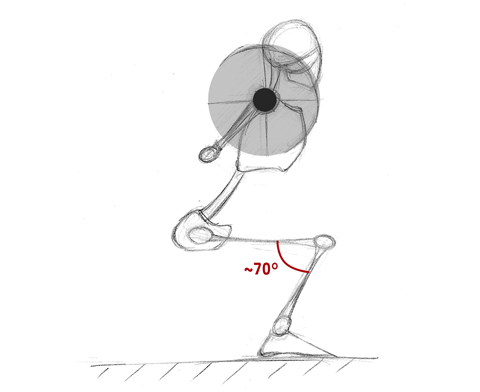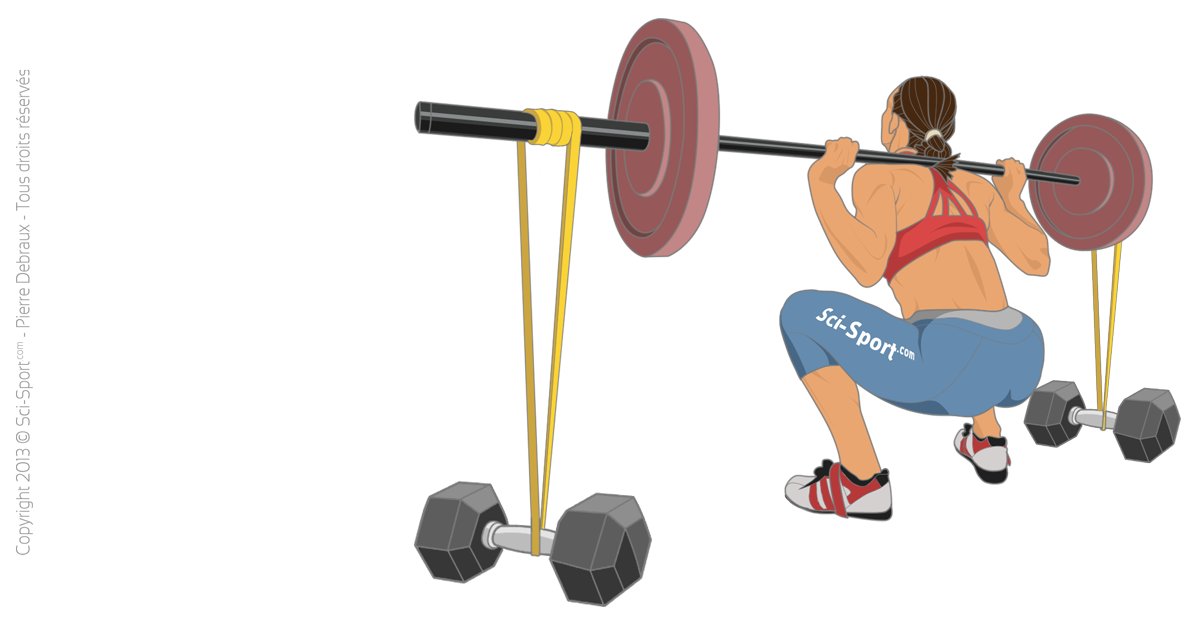
The muscle Force-Speed relationship indicates that the increase in the speed of shortening results in a decrease in the production of force, and vice versa. More simply, if you want to develop maximal force, you will not be able to do it very quickly, and if you want to make a very quick move, you will not develop much force. However, in sports where the qualities of force and speed are related to performance, it is necessary to find a good compromise to produce a significant amount of force as quickly as possible (Fig. 1). Because an athlete with a high level of strength may be unable to develop a significant force in a very short time.

Figure 1. The sprint start requires a high level of explosivity.
It is then necessary to train these two kinetic variables jointly with the objective of improving the explosivity (not to be confused with power). Explosivity, also called rate of force development (RFD, in N/s), can be defined as the amount of force produced per second during the first 300-400 ms of a movement. The higher this value, the more explosive the athlete will be.
For explosivity, the main instruction given to athletes during resistance training is to move the load as quickly as possible. The only drawback of this methodology is the load deceleration inherent in the motion well before the end of the concentric phase. It is a reflex that allows a protection of the joints when they arrive in complete extension. Take the example of the bench press, researchers have shown that the acceleration of the bar during the push (i.e., concentric phase) was only on 60% of the movement. This implies that the deceleration of the bar intervenes on the last 40% of the trajectory. This implies a suboptimal stimulus for the targeted agonist muscles.
There are several techniques to overcome this problem. The first is to project the load at the end of the concentric phase. It can be done by throwing the bar in the bench press or jumping at the end of the squat, but it requires adequate equipment to ensure the safety of athletes (to catch the load at the end of its trajectory). The second technique is to use a variable resistance, such as elastic bands, for example. The principle is that the resistance will increase throughout the concentric phase, which will allow a constant activation of the agonist muscles. But what is the effect on the performance of this type of training ?
To answer this question, in 2009, a team of American researchers from the University of Louisville, USA studied during 12 weeks the effect of different speed of execution in squat using variable resistance with elastic bands (Fig. 2) on the development of strength and power in 48 NCAA Division I male university athletes (baseball, track, American football and basketball).

Figure 2. Parallel squat, thighs parallel to the ground..
Before and after the 12 weeks of the protocol, the athletes performed 2 tests :
The 48 athletes were randomly assigned to 3 groups :
For the 3 groups, the training program during the 12 weeks was the same : 2-3 sessions of resistance training per week at 75-85% of the 1RM (Squat, power clean, deadlift, lunges and romanian deadlift) and 1-2 plyometric and sprint workouts (20-40m sprints, hurdle jumps, depth jumps and split jumps). Only the instructions for the squat were different between the 3 groups. To control speed during each squat repetition, a linear transducer (Tendo) was attached to the bar and real-time feedback was given to athletes for them to know if they were moving at the correct speed. For each group, the selected squat load was the maximum load that each athlete could move at the required speed.

Figure 3. Squat with elastic bands.
The main results showed that only the difference in maximal power between the "Fast with elastic band" group and the "Slow" group was significant. No significant difference was observed between the 3 groups for maximal strength (Table 1). However, researchers also determined average percentages of progression and Effect sizes.
In statistics, significance represents the statistical reproducibility of a study. For example, the level of significance at p = 0.05 means that the results of a study can be expected 95 times out of 100. Nevertheless, based only on the significance, it is possible to miss a significant effect caused by a protocol.
If the number of participants is small or there are large differences among these participants, the risk that the difference is not significant is large. And conversely, on a large number of people, an insignificant difference can be significant...
Therefore, it is recommended to use in addition to the significance, the effect size. The effect size makes it possible to take into account the variations among the individuals of a study and to account for the amplitude of the difference between 2 observations.
In this study, although the difference in maximal strength between the 3 groups is not significant, the percentage progression of the "Slow" and "Fast with elastic band" group is much higher than that of the "Fast" group, which has an effect size "Small". Similarly, for maximal power, the "Fast" and "Fast with elastic band" groups show gains much higher than those of the group "Slow". And the group "Fast with elastic band" has a larger effect size and a higher percentage of progression.

These results show that the qualities of strength and speed can be improved thanks to the training with elastic resistance. The addition of elastic bands to the squat and the fast speed of execution allowed a similar increase in maximal strength compared to the group that used heavier loads, and a higher increase in maximal power compared to the other two groups.

Figure 2. Effect sizes illustrating the neuromuscular changes that occurred after a 12-week squat protocol according to 3 modalities of different speeds and resistances. <0.25: Trivial; 0.25-0.50: Small; 0.50-1.0: Moderate; > 1.0: Large.
In squats, the human body becomes mechanically stronger when it reaches full extension, that is, when it is completely upright. With elastic resistance, the athlete can produce more strength over a longer period of the concentric phase. Moreover, during the eccentric phase, the muscle is probably able to store elastic potential energy, and to restore it in the form of kinetic energy, which will facilitate the concentric phase, and precisely, the elastic resistance accentuates the first part of the eccentric phase. Moreover, the elastic bands are not extended during the first part of the concentric phase which facilitates the acceleration of the movement. It is possible that with motor learning, athletes can learn to take advantage of it. All these points are discussed in our review "Elastic bands: From science to practice" and in more details in our book available on Amazon.fr.
Training with elastic resistance seems to be beneficial to increase both force and speed. It is also important to note that throughout the protocol, squat loads were chosen based on the speed of execution of the movement. At high speed, the addition of elastic bands allowed a better gain of maximal power and force.
In terms of training, the elastic bands are simple to set up and inexpensive. Their additional resistance must be based on the athlete's 1RM. It is also necessary to combine the two types of resistance (i.e., constant [iron] and variable [elastic]) so that the athlete can work at each phase of the movement. Indeed, at the bottom of the movement, the elastic bands will provide less or no resistance, depending on how they are attached. Finally, it is essential for the training with elastic bands to be explosive, because slowing the movement in its eccentric or concentric phase would be counterproductive. The intention of the athlete must always be to maximize the speed of execution, maintaining a correct technique, of course.
It is also possible that training with elastic bands in a performance goal oriented is better suited to experienced athletes. Indeed, novice athletes in resistance training may not fully enjoy the benefit of elastic resistance for lack of strength and / or neuromuscular coordination.
We remind you that you can quote articles by limiting your quotation to 200 words maximum and you must include a nominative link to this one. Any other use, especially copying in full on forum, website or any other content, is strictly prohibited. In doubt, contact us.
Copyright © 2011-2024 - www.sci-sport.com - All rights reserved